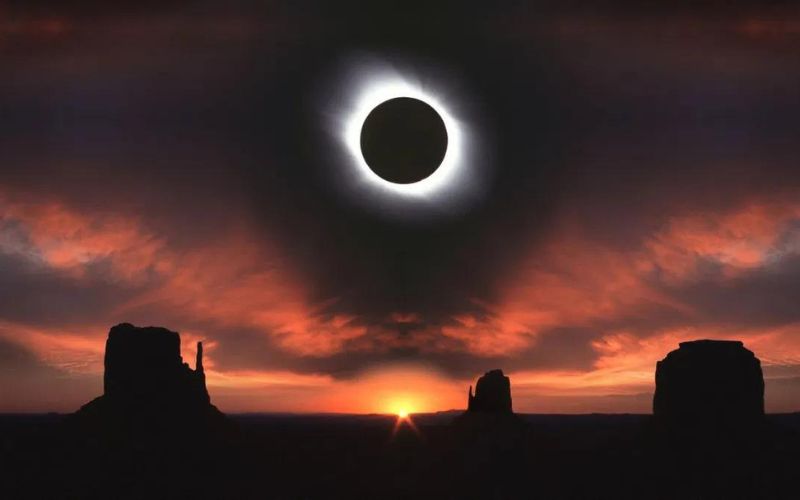On April 8, 2024, India will witness a significant celestial event: a solar eclipse, commonly referred to as “Grahan” in Hindi. This natural phenomenon has fascinated humans for millennia, blending science, mythology, and cultural practices. This article provides a detailed overview of the 8 April 2024 Grahan, including its timings, visibility, scientific significance, and cultural implications in India.
Understanding Solar Eclipses
A solar eclipse occurs when the Moon passes between the Earth and the Sun, blocking all or part of the Sun’s light. Depending on the alignment, there are three types of solar eclipses:
- Total Solar Eclipse: The Moon completely covers the Sun, casting a shadow on Earth.
- Partial Solar Eclipse: Only a part of the Sun is obscured by the Moon.
- Annular Solar Eclipse: The Moon covers the Sun’s center, leaving a ring-like appearance of the Sun’s edges, known as the “ring of fire.”
The 8 April 2024 Solar Eclipse
The solar eclipse on April 8, 2024, will be a total solar eclipse, offering a spectacular display of nature’s grandeur. While the path of totality will primarily cross parts of North America, parts of India will experience a partial eclipse, with varying degrees of coverage depending on the location.
Grahan Timings in India
The timing of the Grahan will vary across different regions in India. Here are the approximate timings for some major cities:
- New Delhi:
- Start Time: 07:30 AM
- Maximum Eclipse: 09:15 AM
- End Time: 10:45 AM
- Mumbai:
- Start Time: 07:45 AM
- Maximum Eclipse: 09:25 AM
- End Time: 10:55 AM
- Kolkata:
- Start Time: 07:15 AM
- Maximum Eclipse: 08:55 AM
- End Time: 10:30 AM
- Chennai:
- Start Time: 07:40 AM
- Maximum Eclipse: 09:20 AM
- End Time: 10:50 AM
These times are subject to minor adjustments based on exact geographic locations. Observers are advised to check local sources for precise timings.
Viewing the Eclipse Safely
Watching a solar eclipse can be a breathtaking experience, but it’s crucial to do so safely. Directly viewing the Sun without proper protection can cause severe eye damage. Here are some safe viewing tips:
- Eclipse Glasses: Use certified eclipse glasses with ISO 12312-2 international safety standards.
- Pinhole Projector: Create a pinhole projector to view the eclipse indirectly.
- Solar Filters: Use telescopes or binoculars equipped with solar filters.
- Never Use Regular Sunglasses: Regular sunglasses, even dark ones, do not provide adequate protection.
The Science Behind the Eclipse
Solar eclipses offer a unique opportunity for scientific observation. They allow scientists to study the Sun’s outer atmosphere, the corona, which is usually obscured by the Sun’s bright light. During a total solar eclipse, the corona becomes visible, enabling researchers to study its structure, temperature, and composition.
Cultural and Religious Significance
In India, solar eclipses hold deep cultural and religious significance. Traditionally, Grahan is considered an inauspicious time, and various rituals are observed:
- Temples Closed: Many temples close their doors during the eclipse.
- Fasting: Some people observe fasting, believing food cooked during an eclipse can be harmful.
- Ritual Baths: Taking a bath before and after the eclipse is common, symbolizing purification.
- Chanting Mantras: Reciting prayers and mantras is believed to protect against the negative effects of the eclipse.
Mythology and Folklore
Indian mythology is rich with stories related to solar eclipses. One of the most popular is the tale of Rahu and Ketu, the demon siblings. According to legend, during the churning of the ocean (Samudra Manthan), Rahu disguised himself as a god to drink the nectar of immortality. However, Vishnu cut off his head before the nectar could pass through his throat. The head, Rahu, and the body, Ketu, became immortal and periodically swallow the Sun and Moon, causing eclipses.
Astrological Impact
Astrology plays a significant role in Indian culture, and eclipses are often linked to astrological predictions. An eclipse can influence various zodiac signs differently, and astrologers provide guidance on how to mitigate potential negative impacts.
Public Reaction and Preparations
As the date of the eclipse approaches, various organizations and institutions will gear up for public education and observation events:
- Planetariums and Science Centers: Many will organize special viewing events and workshops.
- Media Coverage: Extensive media coverage will ensure the public is well-informed about the event and safety measures.
- Schools and Educational Institutions: Many will incorporate the eclipse into their curriculum, providing students with a hands-on learning experience.
Environmental Impact
Interestingly, solar eclipses can also impact the environment. During a total solar eclipse, temperatures can drop significantly, and animals may exhibit unusual behavior, mistaking the eclipse for dusk. Birds may return to their nests, and nocturnal animals may become active.
Conclusion
The solar eclipse on April 8, 2024, will be a momentous occasion for both scientific inquiry and cultural practices in India. While only a partial eclipse will be visible in the country, it promises to be a spectacular event that will captivate millions. By understanding the scientific, cultural, and safety aspects of the Grahan, individuals can fully appreciate and safely observe this celestial phenomenon. Whether you are an avid sky watcher, a student, or someone intrigued by the cultural practices surrounding eclipses, the 8 April 2024 Grahan is an event not to be missed.



